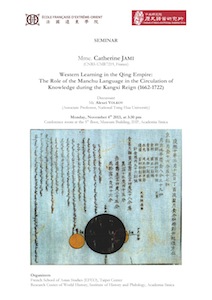
Séminaire : Catherine Jami
04 NOVEMBRE 13
EFEO Taipei & IHP World History Séminaire
Date & lieu :
Lundi, 4 novembre 2013, à 15h30
Salle de conférence au 5è étage, bâtiment du Musée, IHP, Academia Sinica
Par :
Mme Catherine JAMI
(CNRS-UMR7219, France)
Titre:
Western Learning in the Qing Empire: The Role of the Manchu Language in the Circulation of Knowledge during the Kangxi Reign (1662-1722)
Discussant:
M Alexei VOLKOV
(Associate Professor, National Tsing Hua University)
Résumé en anglais :
The Qing conquest of China was a turning point in the history of the sciences practiced and taught by the Jesuits in China. After they entered the Qing civil service as astronomers, some of the Jesuits who worked in Beijing had to learn Manchu, in order to use the language in written reports as well as for oral communication. During the Kangxi reign, they tutored the emperor in several sciences, often using Manchu rather than Chinese. It was in mathematics that their teaching was most systematic and most successful; lecture notes for this discipline in both languages are still extant. In the later part of the reign, they took part in a cartographic survey of the Qing Empire. On the resulting map, the Huangyu quanlantu 皇輿全覽圖, the names for all places outside the Great Wall are written in Manchu. Thus, some of the Jesuits’ work contributed to the sciences of the expanding Qing Empire.
In this talk I will discuss the use of Manchu in the sciences. After a brief review of extant material, I will take a closer look at the lecture notes produced for Kangxi in the 1690s by the French Jesuits Jean-François Gerbillon (張誠, 1654-1707) and Joachim Bouvet (白晉, 1656-1731), examining how a French geometry textbook was translated into Manchu, and then from Manchu into Chinese. This process was part of Kangxi’s policy of constructing a corpus of Manchu literature, which he wanted to include technical as well as classical and historical subjects. But the existence of this corpus of Western learning in Manchu also bears witness to the imperial appropriation of scientific andtechnical fields, through which Kangxi positioned himself as a teacher in the Confucian tradition.
(Le séminaire sera en anglais et animé par Mme Paola Calanca, responsable du centre EFEO à Taipe, et Mme Tai Li-chuan, chercheuse de l'IHP.)
Organisateurs:
• Centre EFEO à Taipei
• Research Center of World History, Institut d'histoire et de philologie, Academia Sinica
Contact:
Centre EFEO à Taipei, IHP, Academia Sinica, Taipei City 11529
TEL: 02 26 52 31 77
MEL: efeotpe@mail.ihp.sinica.edu.tw
conférence
Date & lieu :
Lundi, 4 novembre 2013, à 15h30
Salle de conférence au 5è étage, bâtiment du Musée, IHP, Academia Sinica
Par :
Mme Catherine JAMI
(CNRS-UMR7219, France)
Titre:
Western Learning in the Qing Empire: The Role of the Manchu Language in the Circulation of Knowledge during the Kangxi Reign (1662-1722)
Discussant:
M Alexei VOLKOV
(Associate Professor, National Tsing Hua University)
Résumé en anglais :
The Qing conquest of China was a turning point in the history of the sciences practiced and taught by the Jesuits in China. After they entered the Qing civil service as astronomers, some of the Jesuits who worked in Beijing had to learn Manchu, in order to use the language in written reports as well as for oral communication. During the Kangxi reign, they tutored the emperor in several sciences, often using Manchu rather than Chinese. It was in mathematics that their teaching was most systematic and most successful; lecture notes for this discipline in both languages are still extant. In the later part of the reign, they took part in a cartographic survey of the Qing Empire. On the resulting map, the Huangyu quanlantu 皇輿全覽圖, the names for all places outside the Great Wall are written in Manchu. Thus, some of the Jesuits’ work contributed to the sciences of the expanding Qing Empire.
In this talk I will discuss the use of Manchu in the sciences. After a brief review of extant material, I will take a closer look at the lecture notes produced for Kangxi in the 1690s by the French Jesuits Jean-François Gerbillon (張誠, 1654-1707) and Joachim Bouvet (白晉, 1656-1731), examining how a French geometry textbook was translated into Manchu, and then from Manchu into Chinese. This process was part of Kangxi’s policy of constructing a corpus of Manchu literature, which he wanted to include technical as well as classical and historical subjects. But the existence of this corpus of Western learning in Manchu also bears witness to the imperial appropriation of scientific andtechnical fields, through which Kangxi positioned himself as a teacher in the Confucian tradition.
(Le séminaire sera en anglais et animé par Mme Paola Calanca, responsable du centre EFEO à Taipe, et Mme Tai Li-chuan, chercheuse de l'IHP.)
Organisateurs:
• Centre EFEO à Taipei
• Research Center of World History, Institut d'histoire et de philologie, Academia Sinica
Contact:
Centre EFEO à Taipei, IHP, Academia Sinica, Taipei City 11529
TEL: 02 26 52 31 77
MEL: efeotpe@mail.ihp.sinica.edu.tw
conférence

